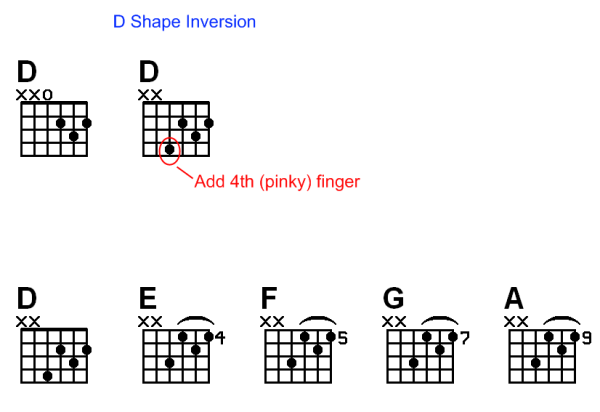Chord Inversions - D Shape
Lesson Goals:
♦ Define chord inversions
♦ Learn D shape chord inversion
♦ Use D shape to play various major chord inversions
A chord inversion is simply a different way of playing a chord at a different location on the neck. We will look today at a way to play some of the major chords that we already know as inversions.
From a music theory point of view, the inversion of a chord is not only played in a different location on the neck, but also "spelled" differently. This means that the "order" of the notes, from low to high (for example) will be re-arranged when the chord is played as an inversion.
Is it important to know these "spellings" and how they are different for every chord inversion. Absolutely not! As you know by now, our main focus is to learn how to put these concepts to work in actual "everyday" playing applications.
Today we will learn some chord inversions for major chords in the "D" shape.
Remember back when we learned barre chords and we discussed them in terms of the "E" shape and "A" shape chords? In those cases we learned how to play barre chords in any position on the neck, but the fingering was based on the shape or pattern of the open E and open A chords.
In today's lesson we will apply the same technique to learning chord inversions. Only this time we will use the shape of the "D" chord to build our inversions.
Let's look the first part of the chord diagram below. First we see the standard, open D chord as we already know it.
Next to that is the shape or pattern we will use to form some chord inversions. As you can see, all you have to do is add the 4th (pinky) finger to the 4th fret of the 4th string.
Give it a try!

Now, all we have to do to play other chords (inversions) using this "D" shape, is slide this whole pattern up the neck to the appropriate fret.
To do this, just remember back to naming the notes on various strings. You may remember that when going from a D note to an E note, you go up a "whole" step (or 2 frets).
Keeping that in mind, if you slide the D shape pattern as shown, up a whole step (2 frets), you are now playing an E major chord inversion.
You may also remember that there is always a half step (1 fret) between E and F, and also, B and C. So therefore, if you slide your E major chord inversion up a half step (1 fret), you are now playing an F major chord inversion.
This same principle applies on up the neck. Slide from the F inversion a whole step (2 frets), and you are playing a G major chord inversion. Slide up a whole step from there and you are now playing an A major chord inversion.
As an exercise, play the open E chord, then play it's inversion. Can you hear the similarities? It's the same chord, only with a different "voicing"
Now repeat that with the other chords in the above example.

